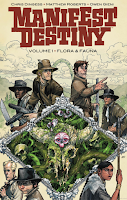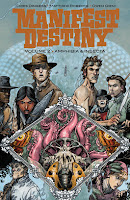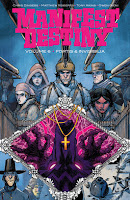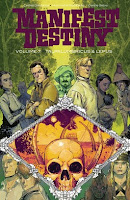 |
| Volume 1. Flora & Fauna (2013) |
With COVID-19 wreaking havoc across the world right now, we
got some problems. But we don’t got Lewis-and-Clark-killing-monsters-across-the-North-American-continent
problems. That’s the premise of Image Comics’ comic book series Manifest
Destiny (2013–present).
Manifest Destiny is smart. It’s gory. It’s funny. I
love it.
Like Seth Grahame-Smith’s 2009 novel Pride and Prejudice
and Zombies, Manifest Destiny is a speculative mash-up, combining
details from its source material, The Journals of the Lewis and Clark Expedition, with dangerous, mythical
monsters. The premise: What if Lewis and Clark’s real mission wasn’t to
explore and map west of the Mississippi River, but to clear it of monsters? Lewis
and Clark and Monsters.
 |
| Volume 2. Amphibia & Insecta (2015) |
The series follows the dates and locations of the actual
Lewis and Clark expedition. The first issue begins on 23 May 1804, while the
three ships of the Lewis and Clark expedition near present-day St. Louis on the
Missouri River. In the first two pages, Meriwether Lewis, the captain of the
expedition, sees a strange bird overhead. Today we might recognize this bird as
a Great Blue Heron, but Lewis is just “discovering” it. Second Lieutenant William Clark
shoots down the bird so that Lewis can study it.
This opening scene represents the expedition’s mission well—to
explore and map the United States’ recent purchase of land west of the
Mississippi River, otherwise known as “the Louisiana Purchase.” This includes
learning about the plants and animals that call the area home. But this is
where we pause, friends . . . page 2.
 |
| Volume 3. Chiroptera & Carniformaves (2016) |
Lovers of Romantic literature should recognize this opening scene as a bad omen. We’ve seen it before in Samuel Taylor Coleridge’s poem “The Rime of the Ancient Mariner.” In the poem, first published in 1798, an old sailor accosts a guest at a wedding to tell him a story. The sailor describes how he was once on a ship that got stuck near the South Pole during a storm. A friendly albatross followed the ship, but the mariner killed the bird for sport and, to paraphrase, boy howdy, did he pay for it.
The other sailors blamed the mariner for the spirit that
punishes them, until a ghost ship driven by a weird death-woman pulls up alongside
and all but the mariner (“Four times fifty living men”) drop dead. It’s not
until the mariner expresses remorse for killing the bird and appreciation
for other living creatures that he is forgiven for killing the albatross and
the spirit that has been hounding him raises all the sailors’ corpses to sail
the ship back home.
 |
| Volume 4. Sasquatch (2016) |
Manifest Destiny starts the same way—with
the killing of a bird. If we are familiar with Coleridge’s poem, we should expect
a lot of death and weird, supernatural sh*t to follow, which is, in fact, what
happens in the series. But this isn’t pointless gore and weirdness. Remember
the wedding guest in Coleridge’s poem? In Manifest Destiny, we
are the wedding guest. The mariner’s warning to the wedding guest is Manifest
Destiny’s warning to us:
Farewell! farewell! but this I tell
To thee, Wedding-Guest!
He prayeth well, who loveth well
Both man and bird and beast.
He prayeth best, who loveth best
All things both great and small;
For the dear God who loveth us,
He made and loveth all.
 |
| Volume 5. Mnemophobia & Chronophobia (2017) |
Like the wedding guest who leaves the encounter “like one
that hath been stunned,” Manifest Destiny wants us to be shooketh.
The Romantics, like Coleridge, had a healthy respect for
nature, often represented by the concept of the sublime—a
feeling of awe or terror in the face of nature’s grand scale. The mariner in
Coleridge’s poem does not respect nature and is therefore punished by experiencing
the terror of the sublime. In particular, he is punished by supernatural forces—nature
and the supernatural (i.e., the divine) are linked. This is ecohorror.
 Manifest Destiny suggests that the Lewis and Clark
Expedition does not have the appropriate respect for nature, and by extension, the
divine. And, in fact, the expedition encounters example after example of ecohorror,
starting with a clever reimagination of today’s St. Louis Arch
Manifest Destiny suggests that the Lewis and Clark
Expedition does not have the appropriate respect for nature, and by extension, the
divine. And, in fact, the expedition encounters example after example of ecohorror,
starting with a clever reimagination of today’s St. Louis Arch
Lewis and Clark soon realize that wherever they find one of
these arches—built
by some unknown deity or species—they will encounter some kind of
monster.




The opening scene of the series, in which Clark casually kills a Great Blue Heron so that Lewis can study it, reinforces the idea that this fact-finding expedition is a form of violence against nature.
 |
| Volume 6. Fortis & Invisibilia (2018) |
This frame of Lewis writing in his journal with a map and
the corpse of the heron suggests that there is little difference between exploring and killing. In fact, Lewis writes in his journal that their mission
is actually “destroying monsters and clearing the way for expansion of our
United States.” In many places in the series, however, it is difficult to tell who
the monsters are.
The title of the series, Manifest Destiny, refers to
the 19th-century belief
that Americans were divinely preordained to settle the land west of the Mississippi
River. Manifest Destiny, the comic book, asks us to think about that
national mission. Preordained by whom or what?
 |
| Volume 7. Talpa Lumbricus & Lepus (2020) |
Get caught up on Volumes 1–6. Volume 7 is forthcoming in May 2020.


